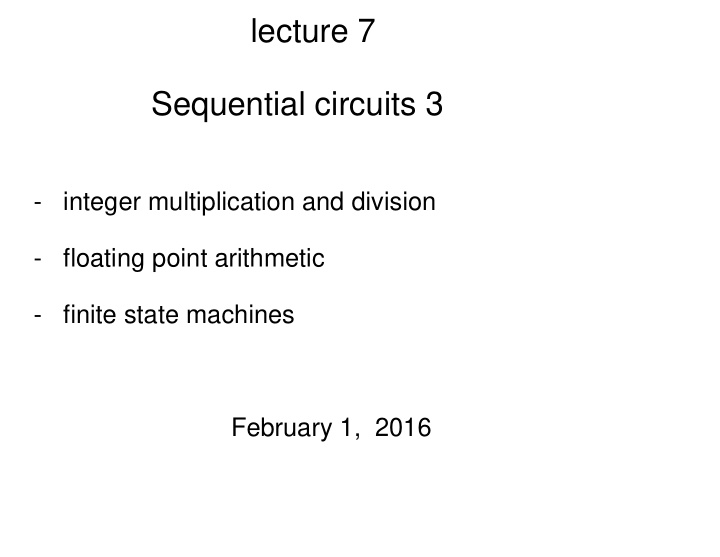



lecture 7 Sequential circuits 3 - integer multiplication and division - floating point arithmetic - finite state machines February 1, 2016
Integer multiplication (grade school)
How to do (unsigned) integer multiplication in binary ? multiplicand multiplier product Why does the product have 2^ bits ?
multiplicand multiplier product
multiplicand multiplier shift left register shift right register Use LSB to decide whether to add the shifted A or not. product
Algorithm: integer multiplication // three instructions below done in parallel extend multiplicand to 2n bits and load into left shift register A load multiplier into right shift register B clear product register // three instruction below done in parallel for counter = 1 to n { if LSB of B is 1` P = P + A shift A left by 1 bit shift B right by 1 bit }
Assignment 1 (Logisim) posted today multiplicand multiplier shift left register shift right register combinational circuit ALU (adder) counter product
Alternative approaches ? multiplicand multiplier product Use a combinational circuit only. Advantages ? Disadvantages ?
Faster (good) and bigger (bad) ? Requires big and fast adders ! (one clock cycle... details omitted)
Use registers. Take several clock cycles. In terms of speed and size of circuit, this one falls between the original approach (Assignment 1) and the approach on the previous slide.
Long Division quotient dividend divisor remainder remainder How would you write out this grade school algorithm? remainder Not obvious !
divisor quotient dividend remainder remainder remainder remainder
Sketch only (ignore register initialization) divisor (shift right register) combinational logic divisor < remainder ? remainder quotient (shift left register)
Algorithm (time permitting)
Recall Floating Point Addition (lecture 2) x = 1.00100100010000010100001 * 2^ 2 y = 1.10101000000000000101010 * 2^ {-3} x + y = ? x = 1.00100100010000010100001 00000 * 2^2 y = .00001101010000000000001 01010 * 2^2 but the result x+y has more than 23 bits of significand
To do floating point addition (or subtraction), we need to: - compare exponents - shift right (x or y with smaller exponent) - use a big adder (recall we can use two's complement to do subtraction or to add with negative numbers) - normalize / shift (or treat specially if the result is non-normalized) - round off Details omitted. I just wanted to mention the basic idea.
Floating Point Multiplication Similar to integer multiplication, but ... - significand must be approximated - we must take care of exponents too, including handling overflow and underflow. (Underflow means getting a non-normalized number.)
Floating Point Division Similar to integer division, but we don't stop when remainder is less than divisor.
Finite State Machines Defined by: - clock (discrete time) - memory ("state" may change with each time step) - input and output values - next state (i+1) depends on current state and/or input (i) - output (i) may depend on currentState and/or input (i)
Finite State Machine called "finite automata" in COMP 330 input i current state i output i nextState i+1 (memory) (memory) The table has variables with values that can be written in binary. However, you cannot implement it with a combinational circuit only. You need sequential circuits too (and a clock to control time).
combinational state circuit (memory) combinational circuit input output The behavior of the machine is determined by an initial state and a sequence of inputs.
e.g. turnstile
e.g. turnstile input current state output next state 0=coin 0=locked 0= ~turn 0=locked 1=push 1=unlocked 1= turn 1=unlocked 0 0 0 0 0 1 0 1 1 0 0 0 1 1 1 1
Announcements - A1 posted today (due Wed. Feb. 10 at 23:59) TA (Josh and Noor) office hours will be posted soon. - Quiz 2 next Monday covers lectures 3-6 lastname A-H write in ARTS 145
Recommend
More recommend